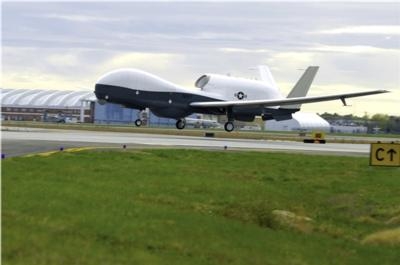Mon, Apr 27, 2015
MFAS Provides 360-Degree View Awareness Over A Large Area
The Navy’s MQ-4C Triton UAS equipped with a new search radar completed its inaugural flight April 18 over Patuxent River air space.

The radar, known as the Multi-Function Active Sensor (MFAS), is expected to greatly enhance maritime domain awareness by providing the MQ-4C with a 360-degree view of a large geographic area while providing all-weather coverage to expedite detecting, classifying, tracking and identifying points of interest.
“This first sensor flight is a huge achievement for the program,” said Sean Burke , Triton program manager. “Our Navy and Northrop Grumman team has worked extremely hard on this developmental effort, completing more than 40 surrogate flights over the last three years, and we saw the realization of that development work.”
During this initial test event, MFAS exercised its primary operating mode, known as Maritime Surface Surveillance (MSS). The MSS mode provides continuous watch over a broad area.
"Our primary objective was to test this new radar, but we also looked at how the aircraft performed as well as testing additional data links," said Lt. Cmdr. Glenn Rioux, government flight test director and senior Air Test and Evaluation Squadron (VX) 20 representative supporting the Triton integrated test team. "This was a successful flight on many levels. We are still reviewing the data and actively planning our next text event."
Along with the MFAS radar, the MQ-4C will also carry an Electro-Optical/Infrared (EO/IR) sensor that will provide still imagery and full-motion video of potential threats; an electronic support measures package to identify and geolocate radar threat signals; and an Automatic Identification System (AIS) that will detect and track vessels equipped with AIS responders.
When operational, the MQ-4C Triton UAS will provide 24/7 ISR coverage virtually anywhere in the world. Its ability to dwell at high altitudes will improve intelligence collection and bring an unprecedented level of maritime domain awareness to the warfighter operating and sustaining up to five orbits across the globe.
(U.S. Navy image)
More News
From 2023 (YouTube Version): Legacy of a Titan Robert (Bob) Anderson Hoover was a fighter pilot, test pilot, flight instructor, and air show superstar. More so, Bob Hoover was an i>[...]
Get The Latest in Aviation News NOW on Instagram Are you on Instagram yet? It's been around for a few years, quietly picking up traction mostly thanks to everybody's new obsession >[...]
Aero Linx: B-52H Stratofortress The B-52H Stratofortress is a long-range, heavy bomber that can perform a variety of missions. The bomber is capable of flying at high subsonic spee>[...]
Altimeter Setting The barometric pressure reading used to adjust a pressure altimeter for variations in existing atmospheric pressure or to the standard altimeter setting (29.92).>[...]
"Knowing that we play an active part in bettering people's lives is extremely rewarding. My team and I are very thankful for the opportunity to be here and to help in any way we ca>[...]
 Classic Aero-TV: Remembering Bob Hoover
Classic Aero-TV: Remembering Bob Hoover ANN FAQ: Follow Us On Instagram!
ANN FAQ: Follow Us On Instagram! ANN's Daily Aero-Linx (05.15.24)
ANN's Daily Aero-Linx (05.15.24) ANN's Daily Aero-Term (05.15.24):Altimeter Setting
ANN's Daily Aero-Term (05.15.24):Altimeter Setting Aero-News: Quote of the Day (05.16.24)
Aero-News: Quote of the Day (05.16.24)



